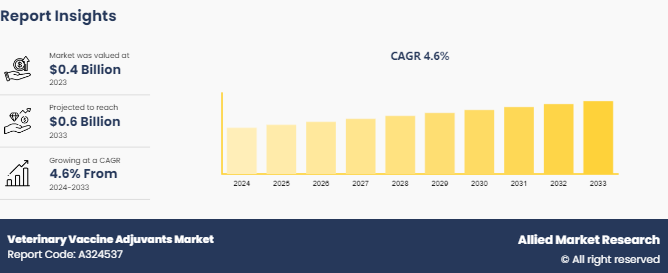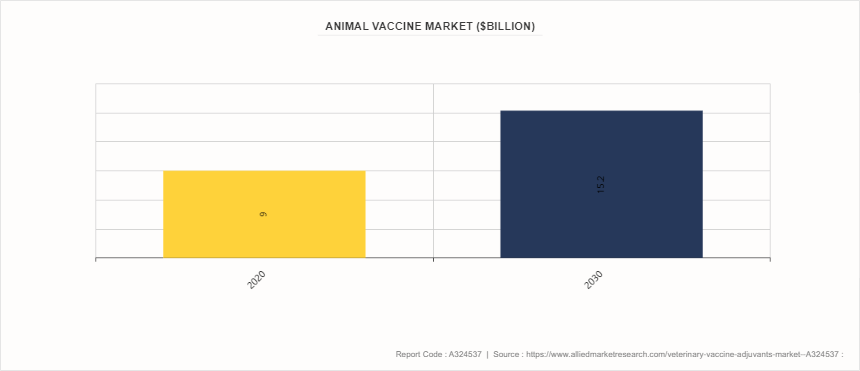Veterinary Vaccine Adjuvants Market Research, 2033
The global veterinary vaccine adjuvants market size was valued at $0.4 billion in 2023, and is projected to reach $0.6 billion by 2033, growing at a CAGR of 4.6% from 2024 to 2033. The major factors driving the groth of the veterinary vaccine adjuvants market are increasing prevalence of zoonotic diseases, growing trend towards pet adoption and advancement in vaccine technology. Additionally, supportive government regulations and initiatives aimed at controlling animal diseases contribute to the market growth.

Market Introduction and Definition
Veterinary vaccine adjuvants are substances that enhance the body's immune response to an antigen, making vaccines more effective. These adjuvants are particularly important in veterinary medicine for ensuring the efficacy of vaccines used in a wide range of animals, from livestock to pets. The primary purpose of an adjuvant is to boost the immune response without the need for high doses of the antigen, thereby enhancing the vaccine's efficiency and durability. Common types of adjuvants used in veterinary vaccines include aluminum salts, oil emulsions, liposomes, saponins, and bacterial derivatives. Aluminum salts, such as aluminum hydroxide, are among the oldest and most widely used adjuvants due to their ability to elicit strong humoral responses. Oil emulsions, such as Freund's incomplete adjuvant, are particularly effective in stimulating both cellular and humoral immunity. Liposomes and saponins can also help deliver antigens more effectively and stimulate a broad immune response. Bacterial derivatives like monophosphoryl lipid A (MPL) mimic pathogen-associated molecular patterns (PAMPs) to trigger robust immune activation. The choice of adjuvant can significantly influence the type and intensity of the immune response, and it can be tailored to the specific needs of the vaccine, such as targeting specific pathogens or improving the duration of immunity.
Key Takeaways
- The veterinary vaccine adjuvants market share study covers 20 countries. The research includes a segment analysis of each country in terms of value ($Billion) for the projected period.
- More than 1, 500 product literatures, industry releases, annual reports, and other such documents of major veterinary vaccine adjuvants industry participants along with authentic industry journals, trade associations' releases, and government websites have been reviewed for generating high-value industry insights.
- The study integrated high-quality data, professional opinions and analysis, and critical independent perspectives. The research approach is intended to provide a balanced view of global markets and to assist stakeholders in making educated decisions in order to achieve their most ambitious growth objectives.
Key Market Dynamics
According to veterinary vaccine adjuvants market opportunity analysis, key factors driving the growth of the market are increase in pet ownership, surge in animal healthcare spending, rise in awareness about animal health, and favorable government initiatives such as animal welfare schemes. Over recent years, there has been a notable rise in the number of households acquiring pets, driven by increasing recognition of the emotional and psychological benefits of pet companionship. According to Health for Animals Organization, in the U.S., 70% of households owned a pet as of 2021 compared to 68% in 2016. The heightened pet population has led to an escalated demand for veterinary healthcare services, including vaccinations. As the adjuvants play crucial role in enhancing the immune response of the animal during vaccination, the demand of adjuvants is expected to rise. Thus the increase in pet ownership, surge in animal healthcare spending is expected to drive the veterinary vaccine adjuvants market size.
According to the veterinary vaccine adjuvants market forecast analysis the growth of the market is largely propelled by a substantial increase in animal healthcare expenditure globally. According to the highlights of the 2024 State of the Industry Report by NAPHIA (North American Pet Health Insurance Association) , the total premium volume for pet insurance in the U.S. was $3.9 billion in 2023. This rise in spending is driven by several factors, including the growing awareness of pet owners and livestock farmers regarding the importance of preventive healthcare measures. As people increasingly view their pets and livestock as integral parts of their families or valuable economic assets, there is a corresponding increase in demand for effective vaccines to protect against a wide array of diseases. Thus, the rise in animal healthcare spending and rise in awareness about animal health is expected to drive the growth of the market.
Parent Market Overview- Animal Vaccine Market
Animal vaccines control the transmission of diseases, thus providing protection to animal and human health, which is essential considering the public dependency on animals. Animals serve as an important source of food, meat, milk, protein, and other commercial products such as leather and wool. Most commonly used veterinary vaccines include rabies vaccines, foot & mouth diseases vaccines, and equine influenza virus vaccines, which prevent the transmission of infectious agents by mimicking the naturally acquired immunity. Constant development of vaccines is essential with rise in emergence of different animal diseases. Increase in pet ownership has significantly accelerated the growth of the market.
Veterinary vaccine adjuvants play a crucial role in enhancing the effectiveness of vaccines by stimulating the immune response in animals. These adjuvants are substances added to vaccines to amplify the immune response to the antigen, which is the key component that triggers immunity against specific pathogens. Thus, the rise in demand for animal vaccine also ensures steady demand for the veterinary vaccine adjuvants.

Market Segmentation
The veterinary vaccine adjuvants industry is segmented into type, application, route of administration, animal type, and region. By type, the market is divided into alum and calcium salts, oil emulsion adjuvants, liposomes and archaeosomes, nanoparticles and microparticles
others. Depending on route of administration, the market is divided into oral, subcutaneous, intramuscular, and others. By type of animal, it is categorized into livestock animals and companion animals. Region wise, the market is analyzed across North America, Europe, Asia-Pacific, and LAMEA.
Regional/Country Market Outlook
North Ameroca dominated the veterinary vaccine adjuvants market share in 2023 owing to technological advancements, significant investments in research and development, well-established veterinary healthcare infrastructure, and a high level of awareness among pet owners and livestock producers regarding the importance of vaccination. In the Asia-Pacific region, rapid market expansion is anticipated due to the growing population of companion animals and increasing commercialization of livestock production. Countries such as China, Japan, and India are emerging as significant contributors, driven by rising disposable incomes and improving healthcare infrastructure.
- According to 2022 National Pet Owners Survey 2023-2024, it was estimated that 66% U.S. households own a pet.
- According to 2024 article by Ministry of Fisheries, Animal Husbandry & Dairying (India) , there are about 535.7 million farm animals and 851.8 million poultry in India.
- In an article published by European Pet Food Industry Federation, it was reported that European pet population grew by 11.48% in 2022
Industry Trends
- According to U.S. Bureau of Labor Statistics, in 2021 in the U.S., pet related expenditure costed around $100 billion. As pet owners spend more on their pets, it reflects a heightened awareness and willingness to invest in the health and well-being of their animals. This trend is likely to drive up the demand for veterinary services, including vaccinations.
- In a 2024 article published by Center of Disease Control and Prevention, it was reported that veterinarians vaccinate over 40 million cats and dogs each year for rabies. Adjuvants are essential components that enhance the immune response to the antigen in vaccines. Thus, the increasing vaccination among the animals is expected to drive the veterinary vaccine adjuvants market growth.
- In May 2024, Department of Animal Husbandry & Dairying (India) , announced FMD (Foot and Mouth diseases) vaccination program. The launch of a large-scale FMD vaccination program will directly increase the demand for FMD vaccines. Veterinary vaccines often require adjuvants to enhance their immunogenicity, ensuring a more robust and long-lasting immune response. As vaccine production scales up to meet the new program’s requirements, the demand for adjuvants is expected to rise.
Competitive Landscape
The major players operating in the veterinary vaccine adjuvants market include SEPPIC, SPI Pharma, Bioveta AS, Croda Internation PLC, Merck & Co., Inc. MVP Laboratories, OZ Biosciences, InvivoGen, Evonik Industries, and Zoetis. Other players in veterinary vaccine adjuvants market include Zhuoyue, Zhiju Bio and Brenntag Biosector.
Recent Key Strategies and Developments
- In December 2022, Evonik Industries launched non-animal-derived squalene suitable for vaccines and other pharmaceutical applications. PhytoSquene is the first known amaranth oil-derived squalene for use in adjuvants in parenteral dosage forms.
Key Sources Referred
- National Pet Owners Survey
- Ministry of Fisheries, Animal Husbandry & Dairying
- Center of Disease Control and Prevention
- European Pet Food Industry Federation
- Health for Animals Organization
- North American Pet Health Insurance Association
- U.S. Bureau Of Labor Statistics
Key Benefits for Stakeholders
- This report provides a quantitative analysis of the market segments, current trends, estimations, and dynamics of the veterinary vaccine adjuvants market analysis from 2024 to 2033 to identify the prevailing veterinary vaccine adjuvants market opportunities.
- The market research is offered along with information related to key drivers, restraints, and opportunities.
- Porter's five forces analysis highlights the potency of buyers and suppliers to enable stakeholders make profit-oriented business decisions and strengthen their supplier-buyer network.
- In-depth analysis of the veterinary vaccine adjuvants market segmentation assists to determine the prevailing market opportunities.
- Major countries in each region are mapped according to their revenue contribution to the global market.
- Market player positioning facilitates benchmarking and provides a clear understanding of the present position of the market players.
- The report includes the analysis of the regional as well as global veterinary vaccine adjuvants market trends, key players, market segments, application areas, and market growth strategies.
Veterinary Vaccine Adjuvants Market Report Highlights
| Aspects | Details |
| Market Size By 2033 | USD 0.6 Billion |
| Growth Rate | CAGR of 4.6% |
| Forecast period | 2024 - 2033 |
| Report Pages | 280 |
| By Type |
|
| By Route Of Administration |
|
| By Type Of Animal |
|
| By Region |
|
| Key Market Players | MVP Laboratories, InvivoGen Corporation., Evonik Industries AG, SEPPIC, Croda Internation PLC, Bioveta AS, Zoetis, Inc., Merck & Co., Inc., OZ Biosciences, SPI Pharma, Inc. |
The forecast period for Veterinary Vaccine Adjuvants Market is 2024-2033.
The total market value of Veterinary Vaccine Adjuvants Market is $0.4 billion in 2023.
The market value of Veterinary Vaccine Adjuvants Market is projected to reach $0.6 Billion by 2033
The base year is 2023 in Veterinary Vaccine Adjuvants Market
Major key players that operate in the Veterinary Vaccine Adjuvants Market are Merck & Co, MVP Laboratories, OZ Biosciences, and InvivoGen.
Loading Table Of Content...


